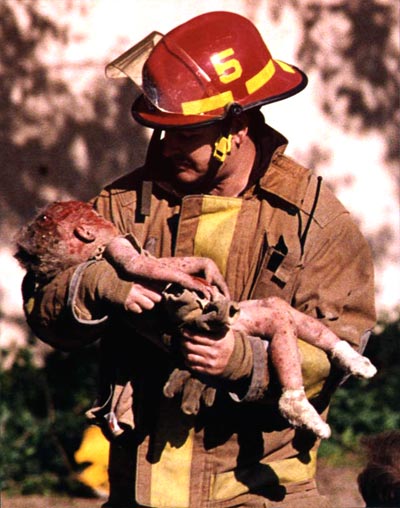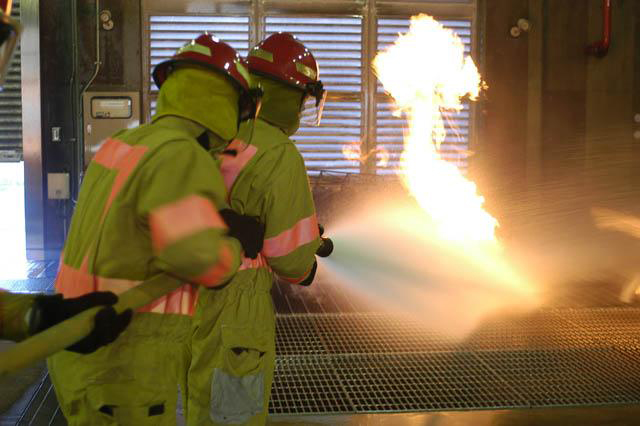
...The Intrepid Firefighter Always Fight Fire With Fired-up Courage
Just as firefighter Jimmy Santos closes his weary ash-colored eyes and places his head on the narrow cot in his lower Manhattan firehouse, the sirens began to wail. He immediately jumps up and reaches for his fire-proof coat, hastily throwing it on over the rest of his uniform, one that still reeks of smoke from the office complex that was ablaze just hours before. He slides down his firehouse's pole, picks up the remainder of his gear, and joins the rest of his company, who are clambering onto their fire truck.
"Where's the fire?" Jimmy asks, as the truck's red lights begin swirling.
"Over on 13th and Sixth," his Captain replies. Why does that location sound familiar, Jimmy wonders. Sixth and 13th, he says to himself, trying to jog his memory, which has been kind of foggy of late. Four major fires in two days will do that, he knows.
"Is the ARA Corporation at 13th and Sixth?" he yells above the clamor, coming to his senses.
"Yeah, apparently something in their kitchen caught on fire," the captain shouted back. "Most of the employees evacuated, but a few people are stuck there."
"Oh, no. That's where my brother's wife, Christine, works!" Jimmy exclaims. He doesn't mention that she's also pregnant. He needs to stay focused on rescuing all individuals and stabilizing the building. Since 9/11 and the horror that he witnessed and survived as he watched the Twin Towers fall, he is still having a hard time concentrating. You need to focus, he reminds himself, as he feels his head begin to throb. His brother needs his help. Maybe I should call him, Jimmy thinks fleetingly. No, that would worry him more. He decides that he'll find Christine and bring her home to the small Cape Cod house she and his brother just moved into, a few streets away from his own duplex where he lives, upstairs from his parents. Think good thoughts, he says to himself.
The smell of smoke reaches Jimmy's nostrils, and he turns his head up. He can see the flames clearly, as they begin to engulf what looks to be the third floor. As soon as the fire truck pulls up alongside the six-story building, Jimmy looks quickly at the evacuees congregated across the street. No Christine. "How many are missing?" he asks the police officer waiting for them.
"Looks like three men and one pregnant woman," the policewoman replies. "They are stuck in the kitchen and have been communicating via cell phone, so they are all hanging in there. But, hurry--you'll have to go up the stairs. The elevator is out of service." Wasting no time, Jimmy puts on his gas mask and rushes into the building with an extinguisher, a few of his fellow firefighters right behind him. The others douse the building's exterior with the truck's hoses and set up a safety net, in case anyone needs to jump. He reaches the third floor in a matter of seconds and surges through the office, his heart pounding. "Christine, can you hear me?" he yells, as he pulls the pin from the fire extinguisher and begins trying to put out the blaze. He can't see a thing, including his guys--the smoke is just too thick. Why isn't anyone answering, he wonders, panicking. Beams above him start to shake, and he realizes he does not have much time. Heading in the direction of the greatest heat, he nearly stumbles on four crouched bodies. He touches what looks like Christine's blond head, and her petrified eyes look up at him. "Jimmy! Thank God!"
"We have to move fast," he urges, as he instructs Christine's three co-workers to move behind him while he and the other firefighters fight the flames that have practically filled the office's kitchen. As soon as Jimmy sees a window, he proceeds to open it and sticks his head out, looking for the safety net below. He spots it as his company sees him at the window. Jimmy signals them to place the net directly below him. He then guides the three businessmen, who are coughing heavily, to the window, and tells them how and where they must jump. At the same time he lifts Christine, who is clutching her belly and staggering. "We're all going to get out of here fine!" he shouts to everybody. "Let's go!" And down the stairs Jimmy and Christine go, while the rest of the firefighters help the businessmen, who are about to jump into the safety net below.
Two minutes later, Jimmy and Christine are safely outside. After placing Christine on the gurney provided by the ambulance corps, who then take her to the hospital to check on her and the baby, Jimmy runs around the corner, soot flying from his normally jet-black hair. He breathes a sigh of relief upon seeing the safety net in place and learning that everyone landed OK. He then stumbles to the nearest pay phone, calls his brother, and lets him know that Christine will be all right as well. It's this bravery, unselfishness, and respect for humanity that makes Jimmy and all the other firefighters worthwhile persons in more ways than a million!
About the Author Prolific author Simeon W. Johnson is a successful author of five books: an entrepreneur With a book and gift boutique: JohnsonandJohnsonGift.com. A former Radio and television electronics technician... He received a master's certification in radio and TV electronics From National Technical Schools, Los Angeles, CA ... He also earned his FCC First Class General Radio and Telephone License




















